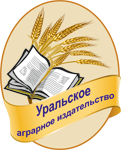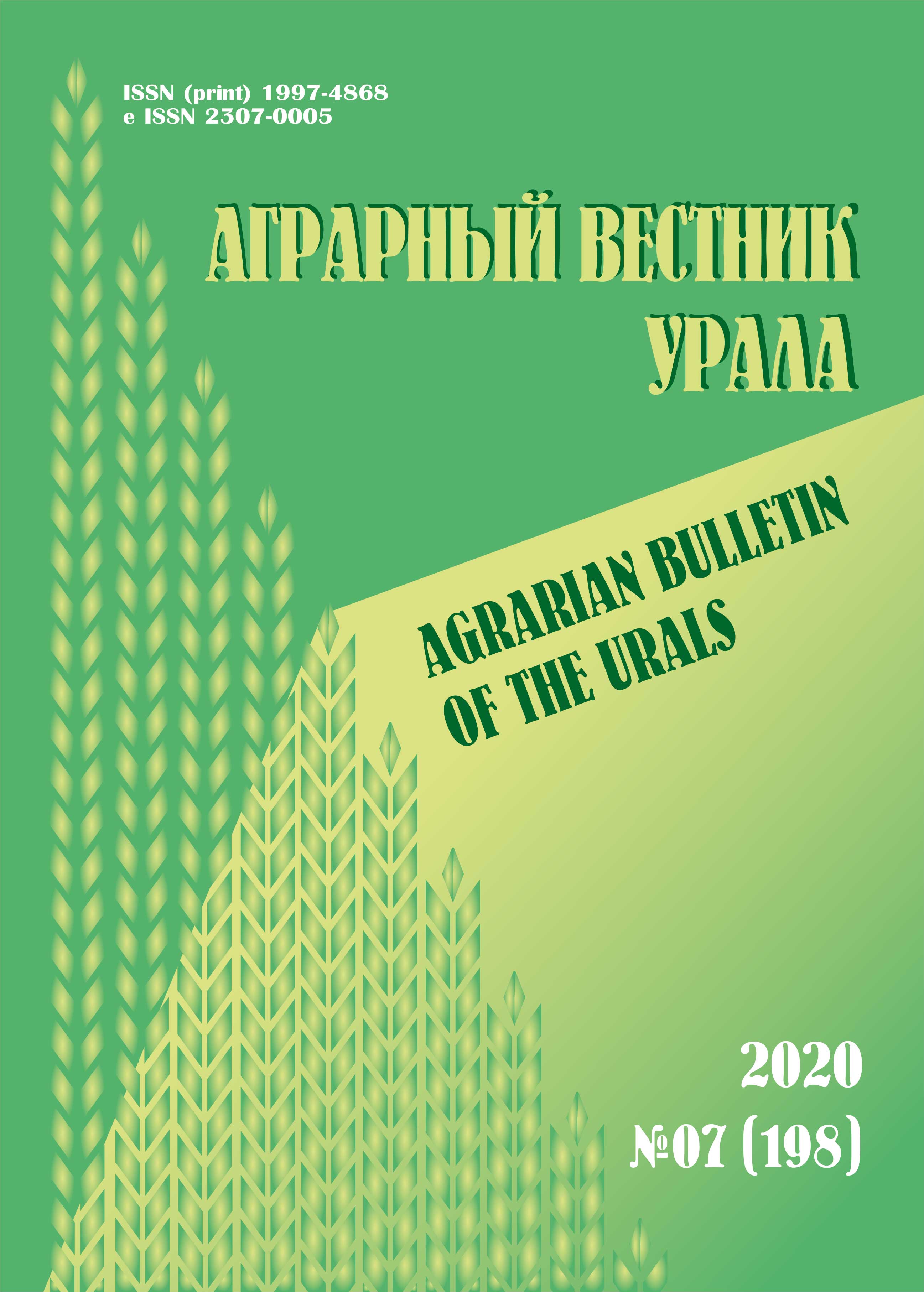Ekaterinburg, Ekaterinburg, Russian Federation
Abstract. Potato is one of the most important human foods. It possesses high taste and nutritional properties. The optimal ratio in potato tubers of organic and mineral substances necessary for a person determines its value as a food product. The tubers contain on average 76–78 % of water and 13 to 36 % of dry matter, of which 12–15 % are starch, 1–3 % protein and about 1 % – mineral compounds. Potato proteins have a very high biological value, since they contain a complex of essential amino acids that are not synthesized in the human body and must be obtained from food. Potatoes are an essential source of vitamin C. The studies were carried out on the experimental field of the educational and experimental farm “Uralets” of the Ural State Agrarian University (USAU), the village of “Studencheskiy”, for three years (2016–2018) in the climatic zone of the Middle Urals. Purpose of research. The objective of this study was to study the influence of the feeding area of “Gala” potato, the use of fungicides on the yield and quality of tubers in the conditions of the Middle Urals. Results. The results analysis on the mineral and biochemical composition of tubers showed that the total nitrogen content changed from 0.25 to 0.37 % and did not depend on the feeding area. The phosphorus content varied from 0.034 to 0.063 % and depended on the feeding area, i. e. the less often the plantings were, the more phosphorus was contained. Potassium content fluctuated over the years. The starch content was stable and did not depend on weather conditions and feeding area and ranged from 11.3 to 15.4 %. The tasting result showed that the studied potato variety Gala has high taste. According to the taste assessment, the Gala variety was rated 5 points in the control variant. The variant with the use of the fungicide shirlan yielded to it by 0.5 points. Scientific novelty. The scientific novelty lies in the fact that for the first time in the conditions of the Middle Urals, the influence of the feeding area on the mineral and biochemical composition of potato tubers (nitrogen, phosphorus, potassium, dry substances, vitamin C and others).
potato, tuber quality, mineral composition, biochemical composition, nutritional area, fungicide, tasting, taste assessment
1. Degebasa A. S. Prospects and Challenges of Postharvest Losses of Potato (Solanum Tuberosum L.) in Ethiopia // Global Journal of Nutrition & Food Science. 2020. No. 2 (5). Pp. 1-10. DOI:https://doi.org/10.33552/GJNFS.2020.02.000550.
2. Hameed A., Zaidi S., Shakir S., Mansoor S. Applications of new breeding technologies for potato improvement // Reviez frontiers in Plant Science. 2018.Vol. 9. Pp. 1-15. DOI:https://doi.org/10.3389/fpls.2018.00925. EDN: https://elibrary.ru/YIJHCP
3. Devyatkina L. N., Sakov A. P., Ignatiev E. N., Polozova V. P. Scenarnoe prognozirovanie razvitiya kartofelevodstva s uchetom trebovaniy prodovol’stvennoy bezopasnosti regiona [Scenario prediction of the development of potato growing, taking into account the requirements of food security in the region] [e-resource] // Moscow Economic Journal. 2016. No. 3. Pp. 270-314. URL: http://qje.su/ekonomika-apk/moskovskij-ekonomicheskij-zhurnal-3-2016-3/?print=print (appeal date: 07.10.2020). (In Russian.)
4. Halterman D., Guenthmer I., Collinge S., Butler N., Douches D. Biotech potatoes in the 21st century: 20 years since the first biotech potato // American Journal of Potato Research. 2016. No. 93. Pp. 1-20. DOI:https://doi.org/10.1007/s12230-015-9485-1. EDN: https://elibrary.ru/OXUJYM
5. Hengsdijk H. W., De Boer J. Post-harvest management and postharvest losses of cereals in Ethiopia // Food security: the science, sociology and economics of food production and access to food. 2017. No. 9. Pp. 945-958. DOI: https://doi.org/10.1007/s12571-017-0714-y; EDN: https://elibrary.ru/CVLLMY
6. Hung P. V., Vien N. L., Phi N. T. L. Resistant starch improvement of rice starches under a combination of acid and heat-moisture treatments // Food Chemistry. 2016. No. 191. Pp. 67-73.
7. Karpukhin M. Yu., Krupskiy I. N., Keita F. Tehnologiya vozdelyvaniya kartofelya na Srednem Urale [Potato cultivation technology in the Middle Urals: scientific and practical recommendations]. Ekaterinburg: Ural State Agrarian University, 2016. 15 p. (In Russian.)
8. Karpukhin M. Yu. Proektnyy keys: Razrabotka tehnologiy promyshlennogo vozdelyvaniya i semenovodstva kartofelya na osnove sovremennykh biotekhnologicheskikh metodov [Design case: development of technologies for industrial cultivation and seed production of potatoes based on modern biotechnological methods]. Ekaterinburg: Ural State Agrarian University, 2017. 21 p. (In Russian.)
9. Tunio M. H., Gao J., Shaikh S. A., Lakhiar I. A., Qureshi W. A., Solangi K. A., Chandio F. A. Potato production in aeroponics: An emerging food growing system in sustainable agriculture for food security // Chilean journal of agricultural research. 2020. No. 80 (1). Pp. 118-132. DOI:https://doi.org/10.4067/S0718-58392020000100118. URL: https://scielo.conicyt.cl/pdf/chiljar/v80n1/0718-5839-chiljar-80-01-118.pdf (appeal date: 07.10.2020).
10. Ngobese N. Z., Workneh T. S., Alimi B. A., Tesfay S. Nutrient composition and starch characteristics of eight European potato cultivars cultivated in South Africa // Journal of food composition and Analysis. 2017. No. 55. Pp. 1-11.
11. Parameswaran R., Bhuvaneswar P. T. V. Detection of macro and micro nutrients in potatoes using elemental analysis techniques // International Journal of Recent Technology and Engineering (IJRTE). 2020. Vol. 8, Iss. 5. Pp. 1033-1040. DOI:https://doi.org/10.35940/ijrte.E6245.018520.
12. Sharipova D. S., Aitbayev T. E., Tazhibayev T. S., Nacheva E. K. The Impact of New and Improved Elements of Agricultural Technologies on Potato Productivity in the South-east of Kazakhstan // Biosciences Biotechnology Research Asia. 2016. Vol. 13 (2). Pp. 1031-1036. DOI:https://doi.org/10.13005/bbra/2129. EDN: https://elibrary.ru/XLIKHF
13. Simakov E. A., Anisimov B. V., Mityushkin A. V., Zhuravlev A. A., et al. Sorta kartofelya selektsionnogo centra VNIIKKH [Potato varieties of the breeding center of the All-Russian Research Institute of Potato Farming]. Consumer and dining quality, culinary type. Moscow, 2016. 38 p. (In Russian.)
14. Swieca M., Dziki D., Gawlik-Dziki U. Starch and protein analysis of wheat bread enriched with phenolics-rich sprouted wheat flour // Food Chemistry. 2017. No. 228. Pp. 643-648.
15. Tumanyan A. F., Tyutyuma N. V., Shcherbakova N. A. Biohimicheskiy sostav i kachestvo stolovykh sortov kartofelya, vyrashchivaemykh na svetlo-kashtanovykh pochvakh Astrahanskoy oblasti kapel’nym orosheniem [Biochemical composition and table quality of potato varieties grown in light chestnut soils of the Astrakhan region on drip irrigation] // Vestnik RUDN. Series: Agronomy and Livestock, 2016. No. 2. Pp. 1-8. (In Russian.)
16. Zaheer K., Akhtar M. H. Potato production, usage, and nutrition // Critical Reviews in Food Science and Nutrition. 2016. No. 56. Pp. 711-721. DOI:https://doi.org/10.1080/10408398.2012.724479.
17. Zhou L., Mu T., Ma M., Zhang R., Sun Q., Xu Y. Nutritional evaluation of different cultivars of potatoes (Solanum tuberosum L.) from China by grey relational analysis (GRA) and its application in potato steamed bread making // Science Direct, Journal of Integrative Agriculture. 2019. No. 18 (1). Pp. 231-245. DOI:https://doi.org/10.1016/S2095-3119(18)62137-9.









